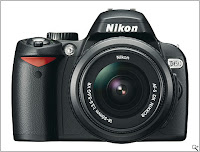
Extraordinary 10.2-Megapixel DX-format Nikon Picture Quality: Nikon's high-performance, 10.2-megapixel DX-format CCD imaging sensor and exclusive EXPEED image processing concept provide added cropping freedom and the ability to make larger prints.
Includes AF-S DX NIKKOR 18-55mm f/3.5-5.6G VR (Vibration Reduction) Image Stabilization Lens: NIKKOR lenses are famous for breathtaking sharpness and faithful color. With Nikon's fast, accurate autofocus and Vibration Reduction (VR) image stabilization technology built in, pictures are even sharper, free from blur caused by camera shake when shooting hand-held.
Fast Startup and Split-Second Shutter Response: With fast startup and split-second shutter response, the D60 eliminates the frustration of shutter delay, capturing moments that other cameras miss.
Shoot Continuously at up to 3 Frames per Second: Capture sports action, precious moments and fleeting expressions at up to 3 frames per second, for as many as 100 consecutive JPEG images.
Active Dust Reduction System with Airflow Control: Nikon's Active Dust Reduction System activates automatically, along with Airflow Control technology to reduce the amount of dust that reaches the sensor.
Easy Operation with Intuitive Controls: Intuitive controls and an onboard HELP Menu System with Assist Images make the D60 truly easy to use, enabling everyone to capture beautiful memories perfectly.
Nikon's EXPEED Image Processing Concept: Nikon's original digital image processing concept, EXPEED, comprehensively optimizes pictures, shot after shot.
8 Digital-Vari Program Automatic Shooting Modes: Eight Digital Vari-Program Modes include: Auto, Auto Flash-OFF, Portrait, Landscape, Child, Sports, Close Up and Night Portrait; each of which adjusts automatically for optimal results for everyday shooting situations. Each mode considers lighting conditions and possibilities, aperture, shutter speed, white balance, hue, tone, sharpening and more to make creative photography as simple as rotating the mode dial.
Nikon's Smallest Digital SLR Ever! Beautifully styled, the D60 makes high-performance digital SLR photography easier and more convenient than ever. You'll be amazed at the power packed into a camera that weighs just over 16 ounces.
2.5-Inch, 230,000-Dot Color LCD Monitor with 170-Degree Wide-Angle Viewing: Playback images are easy to see and function menus are easier to use with a larger and brighter color LCD monitor. The large 2.5-inch LCD monitor enables image preview at up to 19 times magnification and has large type fonts with easy-to-view menus. Auto rotating LCD display provides automatic horizontal and vertical graphic display orientation.
Advanced HELP Menu System with Assist Images: The D60's Assist Images help you select the appropriate settings for many camera features by showing an example image typical of that setting, as well as an advanced HELP Menu for the current item selected. The D60's Question Mark icon (?) indicates that help is available for the currently selected item; just press the HELP button beside the LCD monitor to see a context-sensitive HELP page.
Nikon 3D Color Matrix Metering II: The D60's 3D Color Matrix Metering II evaluates each scene for brightness, color, contrast, size and position of shadows and highlights, selected focus area and camera-to-subject distance, comparing that information against an onboard database of more than 30,000 actual photographic scenes. The result delivers instantly and precisely determined exposures for each scene, even in challenging lighting conditions.
Image Optimization Options: The D60's Optimize Image setting lets photographers adjust color, contrast and sharpening, as well as other image settings, according to the type of scene or output desired. Settings include: Normal, Softer, Vivid, More Vivid, Portrait, Custom and Black and White, each of which are automatically adjusted based on sophisticated Nikon algorithms or user-selected settings for optimum results.
Built-in Speedlight with i-TTL Automatic Flash Control: Nikon's innovative i-TTL flash control evaluates flash exposure with incredible precision to achieve better automatic flash balance and deliver outstanding results. The built-in Speedlight is always at the ready and brings beautiful exposures in darkened conditions, as well as adding sparkle for fill flash in outdoor situations for enhanced twilight shots or an added impact to daylight images. In low-light or back-light situations, added illumination from the built-in Speedlight can make the difference between an average snapshot and a dazzling picture.
Fast, Accurate 3-Area Autofocus: The D60's advanced 3-Area AF system and the refined algorithms inherited from more advanced Nikon digital SLR cameras deliver fast, efficient and precise Autofocus. AF refinements deliver greater precision with fast, more consistent subject acquisition and improved focus tracking for consistently sharper pictures.
In-Camera Image Editing and Enhanced Retouch Menu: Highly versatile in-camera editing features through the Retouch Menu include Nikon D-Lighting, Red-Eye Correction, Image Trim, Image Overlay, Monochrome (Black and White, Sepia and Cyanotype) along with Skylight, Warm Tone and Color Balance filter effects. New effects and controls include Quick Retouch, NEF (RAW) Processing, Cross Star and Color Intensifier filters. This provides greater creative freedom without the need for a computer for those who prefer to send pictures directly to a printer.
Stop motion video: Creates a stop-motion animation from a sequence of images for added creative fun to your pictures.
Up to 500 Images per Battery Charge: The supplied EN-EL9 rechargeable battery will allow for shooting up to 500 images per charge based on CIPA battery testing standards.
Supplied accessories (may differ by country or area): EN-EL9 Rechargeable Li-ion Battery, MH-23 Quick Charger, UC-E4 USB Cable, DK-20 Rubber Eyecup, AN-DC1 Camera Strap, BF-1A Body Cap , DK-5 Eyepiece Cap, BS-1 Accessory Shoe Cover, Software Suite CD-ROM



